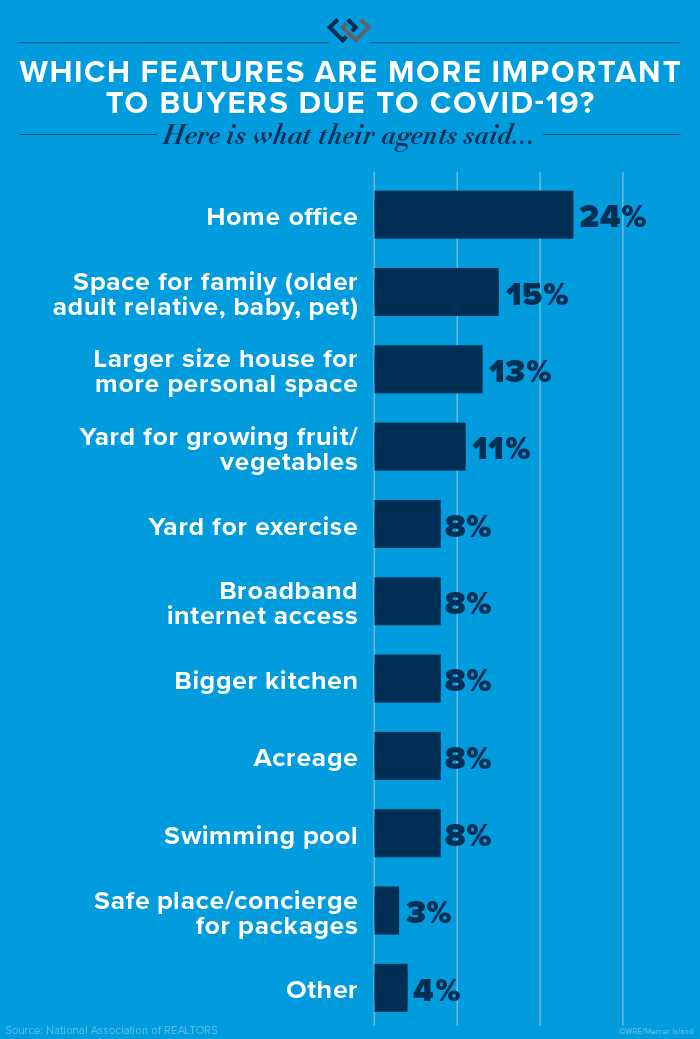Should You Remodel or Sell Your Home As Is?

Homeowners who are preparing to sell are often faced with a dilemma about whether to remodel or sell their home in its current state. Each approach has its respective advantages and disadvantages. If you decide to remodel your home, it will likely sell for more; but the increased selling price will come at the cost of financing the remodeling projects. If you decide to sell without remodeling, you won’t spend as much money putting your home on the market, but the concern is whether you’re leaving money on the table.
Should I Remodel or Sell My Home As Is?
To answer this question, it’s important to understand the factors that could influence your decision and to work closely with your agent throughout the process.
Cost Analysis: Home Remodel vs. Selling Your Home As Is
Home Remodel
When you remodel your home before selling, you’re basically making a commitment to spend money to make money. So, it’s important to consider the kind of ROI you can expect from different remodeling projects and how much money you’re willing to spend. Start by discussing these questions with your agent. They can provide you with information on what kinds of remodels other sellers in your area are making and the returns they’re seeing as a result of those upgrades. This will help you determine the price of your home once your remodel is complete.
Then, there’s the question of whether you can complete you remodeling projects DIY or if you’ll need to hire a contractor. If hiring a contractor seems expensive, know that those costs come with the assurance that they will perform quality work and that they have the skill required to complete highly technical projects.
According to the Remodeling 2021 Cost vs. Value Report for Seattle (www.costvsvalue.com1), on average, Seattle-area homeowners paid $28,967 for a midrange bathroom remodel and $29,183 for a minor kitchen remodel, with a 76.9% and 87.7% ROI respectively. This data shows that, for these projects, you can recoup a chunk of your costs, but they may not be the most cost-effective for you. A more budget-friendly approach to upgrading these spaces may look like repainting your kitchen cabinets, swapping out your old kitchen backsplash for a new one, refinishing your bathroom tub, or installing a new showerhead. Other high-ROI remodeling projects may allow you to get more bang for your buck, such as a garage door replacement or installing stone veneer. To appeal to sustainable-minded buyers, consider these 5 Green Upgrades that Increase Your Home Value.
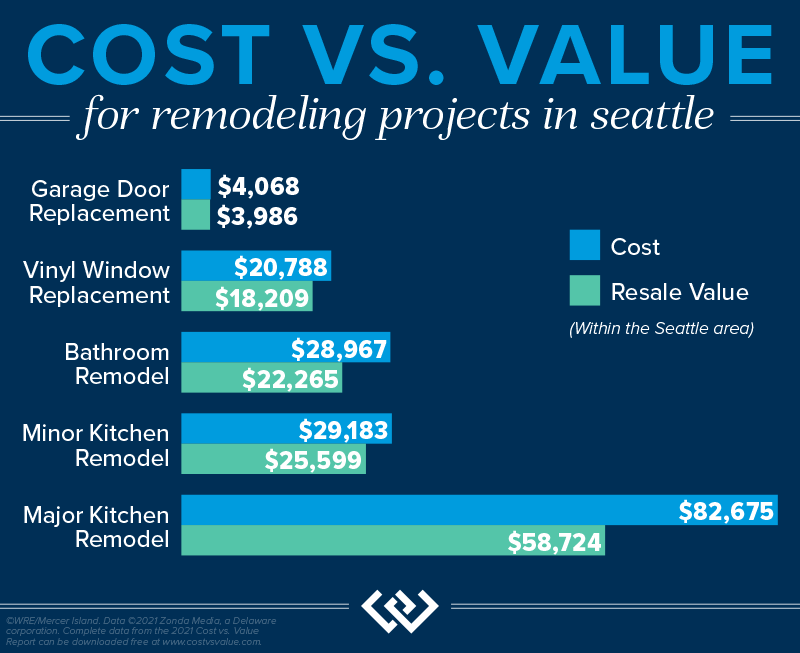
Selling Your Home As Is
Deciding not to remodel your home will come with its own pros and cons. By selling as is, you may sell your home for less, but you also won’t incur the cost and headache of dealing with a remodel. And since you’ve decided to sell, you won’t be able to enjoy the fruits of the remodel, anyway. If you sell your home without remodeling, you may forego the ability to pay down the costs of buying a new home with the extra money you would have made from making those upgrades.
Market Conditions: Home Remodel vs. Selling Your Home As Is
Local market conditions may influence your decision of whether to remodel before selling your home. If you live in a seller’s market, there will be high competition amongst buyers due to a lack of inventory. You may want to capitalize on the status of the market by selling before investing time in a remodel since prices are being driven up, anyway. If you take this approach, you’ll want to strategize with your agent, since your home may lack certain features that buyers can find in comparable listings. In a seller’s market, it is still important to make necessary repairs and to stage your home.
In a buyer’s market, there are more homes on the market than active buyers. If you live in a buyer’s market, you may be more inclined to remodel your home before selling to help it stand out amongst the competition.
Timing: Home Remodel vs. Selling Your Home As Is
Don’t forget that there is a third option: to wait. For all the number crunching and market analysis, it simply may not be the right time to sell your home. Knowing that you’ll sell your home at some point in the future—but not right now—will allow you to plan your remodeling projects with more time on your hands which could make it more financially feasible to complete them.
For more information on how you can prepare to sell your home, connect with one of our local agents—we’re always happy to chat about your situation and offer advice.
1©2021 Zonda Media, a Delaware corporation. Complete data from the 2021 Cost vs. Value Report can be downloaded free at www.costvsvalue.com.
This article originally appeared on the Windermere blog January 10, 2022. Written by: Sandy Dodge.
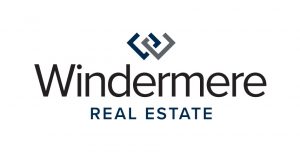
We earn the trust and loyalty of our brokers and clients by doing real estate exceptionally well. The leader in our market, we deliver client-focused service in an authentic, collaborative, and transparent manner and with the unmatched knowledge and expertise that comes from decades of experience.
© Copyright 2022, Windermere Real Estate/Mercer Island.
2022 Home Trends

Hello 2022! Life in the new normal goes on, and with it continues a trend toward all things natural and nostalgic. We’re still seeing the Scandinavian concept of “hygge” live on in warm accents and cozy textiles, but with a newer emphasis on “perfect imperfection” (known as “wabi-sabi” in traditional Japanese art). Irregular curves, handmade decor, and mismatched kitsch are slowly creeping in on the cleaner lines of minimalism. With it comes an earthier palette and an emphasis on sustainable and reclaimed materials…

What started with a houseplant trend has bloomed into a full-blown biophilic craze–borrowing from a design concept centered around bringing the outdoors in. Now plants are going beyond the pot into integrated indoor gardens, floral ceilings, greenery-inspired motifs, and plant-focused decor/furniture all designed to create a visual connection with nature. We’re also seeing a focus on natural lighting and fresh air, with folding window walls and alfresco living spaces increasing in prominence.
Looking for a houseplant refresh? Try a sansevieria (a.k.a. Snake Plant)–not only is it easier to care for than last year’s fiddle leaf fig, a NASA Clean Air Study found that it’s capable of removing pollutants such as formaldehyde, xylene, and toluene from the air in addition to CO2.

Another extension of the nature trend, organic curves are gradually usurping the sharper geometric shapes of recent years. From curvy, retro furniture to barrel-vaulted ceilings and archways, design is taking a softer turn. A recent Pinterest report also showed trending searches for curved walls, bars, and kitchen islands.

Shades of green and warm neutrals are the “it” home colors for 2022, shifting a bit away from cooler whites and steel greys. Rich earth tones such as camel and terracotta are cropping up as accent colors to promote that cozy, hygge vibe. Nature-inspired blue also remains in the palette. We’re seeing a continued turn toward earthier gold and bronze metal hardware (in addition to contrasting black).
Layers of texture follow the earthy trend—look for natural linen and bouclé textiles, along with a mix of wood, leather, metal, and stone for furniture and accessories. Textured walls are also trending with faux plaster and limewash paint on the rise.

Open floor plans still reign supreme (even post-quarantine), but all that working from home has made us think about how we can make our spaces more adaptable. Pocket doors, decorative screens, and kitchen islands are being seen as a way to create some division without permanently disrupting flow or line of sight.
Multi-functional furniture and rooms are also increasingly popular. Whether it’s a desk placed behind the living room couch, an ottoman with a pull-out desktop, or an integrated nook, the concept of “entangled” spaces without clear use delineations is something many people are embracing.
As an add-on to flowing public spaces, private “emotional escape rooms” are one of Pinterest’s predicted trends for 2022. Tiny library rooms, music-themed rooms, and massage rooms are all trending in searches. Home theaters are making a comeback after previously being eschewed for taking up too much space. Yoga studios and intimate lounges are also appearing more frequently on architectural wish-lists.

As supply issues have limited the supply of new furniture and decor, consumers are turning to high-quality vintage and flea market finds for a trendy, sustainable alternative. People are also infusing their personality into a more “maximalist” design concept with gallery walls full of favorite art/photos, richly patterned rugs, antique statement pieces, and favorite objects (such as guitars) incorporated into their decor.
Consumers are also putting more thought into the ethics of what they buy and where they buy it—especially as younger eco-friendly generations begin to purchase and remodel homes. Sustainable materials and energy-efficient products are in higher demand than ever. Reclaimed, locally sourced, and responsibly made furnishings are also trending in popularity.
Need an easy refresh? Try adding throw pillows, blankets or artwork in hues from Pantone’s Spring/Summer 2022 color palette. For paint inspiration, check out the latest trends on Sherwin-Williams’ blog.

We earn the trust and loyalty of our brokers and clients by doing real estate exceptionally well. The leader in our market, we deliver client-focused service in an authentic, collaborative, and transparent manner and with the unmatched knowledge and expertise that comes from decades of experience.
© Copyright 2022, Windermere Real Estate/Mercer Island.
Protect Your Investment: 5 Fall Maintenance To-Do’s

Benjamin Franklin once wrote, “An ounce of prevention is worth a pound of cure.” While he was talking about fire safety, I think it applies equally well to home maintenance. One weekend of prevention this fall can save you many headaches (and a lot of money) down the road. Here are a few ideas to get you started:
1. Gutters, top to bottom
Water in the wrong spots can do a lot of damage. Start by ensuring that gutters and downspouts are doing their job. (You may want to hire a professional, especially if you have a two-story house with a steep roof.) If your home is surrounded by deciduous trees you may need to clean out your gutters a few times a year, especially in the fall. Check to make sure your gutters are flush with the roof and attached securely, repairing any areas that sag or where the water collects and overflows. Clean out the gutters and downspouts, checking that outlet strainers are in good shape, and are firmly in place. Finally, check that your downspouts direct water away from your house, not straight along the foundation.

2. Check for leaks
The best opportunity to catch leaks is the first heavy rain after a long dry spell. Check the underside of the roof, looking for moisture on joints or insulation. Mark any spots that you find and then hire a roofing specialist to repair these leaks. If you wait until spots show up on your ceiling, insulation and sheet rock will have also been damaged and you could have a mold problem too. You can find tips on how to solve roof & gutter issues in this great article from http://FamilyHandyman.com.
Don’t forget the basement and the caulking around windows & doors. Check your foundation for cracks, erosion and gaps in window and door weathering. Make sure to properly seal any leaks while the weather is nice. This will ensure materials dry properly.
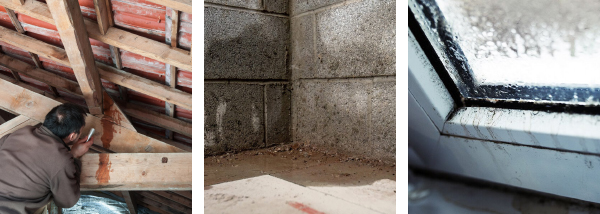
3. Prevent pests
Rodents are determined and opportunistic, and they can do tremendous amounts of property damage (and endanger your family’s health). As temperatures cool, take measures to prevent roof rats and other critters from moving in. Branches that touch your house and overhang your roof are convenient on-ramps for invaders, so trim back branches so they’re at least four feet from the house. If you have a chimney, make sure it has a protective cap. Walk around your home and take a look at the siding and roof soffits—replace any damaged panels, caulk gaps, and fill or screen any holes where critters might gain access.
If you do hear scuttling overhead or discover rodent droppings in your attic, crawl space or basement, take immediate action. The website http://www.thisoldhouse.com has several helpful articles on the topic.

4. Maintain your heating and cooling systems
Preventative maintenance is especially crucial for your home’s heating and air-conditioning systems. Fall is a smart time to have your systems checked and tuned up if necessary. Don’t wait for extreme temperatures to arrive, when service companies are slammed with emergency calls. Between tune-ups, keeps your system performing optimally by cleaning and/or replacing air filters as needed.
If you have a wood-burning fireplace, a professional inspection and cleaning will help prevent potentially lethal chimney fires and carbon monoxide poisoning. Even if you don’t use your fireplace often, it’s a good idea to keep a supply of dry firewood or sawdust-composite logs so you have a backup heat source in an emergency. Gas fireplaces should be serviced about every 2 years to lengthen their lifespans.
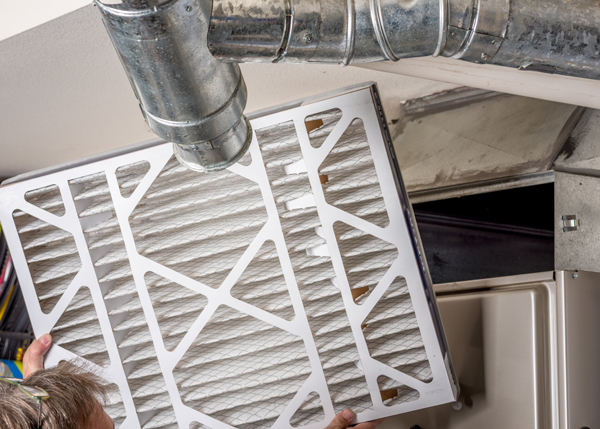
5. Insulate & seal
Insulating your home is a cost-efficient investment, whether you’re trying to keep the interior warm in the winter or cool in the summer. Aside from more major improvements like energy-efficient windows and insulation, there are some quick fixes that do-it-yourselfers can tackle. If an exterior door doesn’t have a snug seal when closed, replace the weather stripping; self-adhesive foam stripping is much simpler to install than traditional vinyl stripping. If there is a gap under the door (which can happen over time as a house settles), you may need to realign the door and replace the vinyl door bottom and/or door sweep. Air also sneaks inside through electrical outlets and light switches on exterior walls. Dye-cut foam outlet seals placed behind the wall plates are a quick and inexpensive solution.


We earn the trust and loyalty of our brokers and clients by doing real estate exceptionally well. The leader in our market, we deliver client-focused service in an authentic, collaborative, and transparent manner and with the unmatched knowledge and expertise that comes from decades of experience.
© Copyright 2021 Windermere Mercer Island
The Four Phases of Remodeling
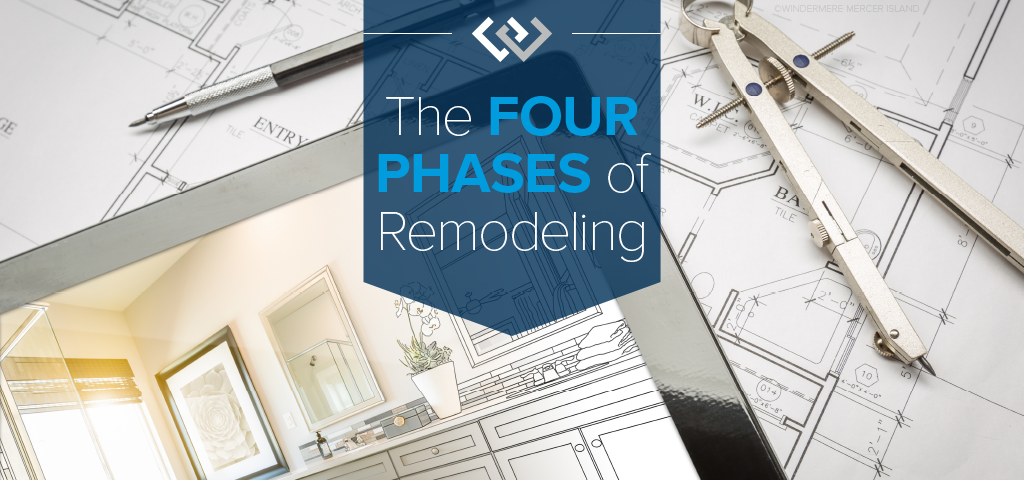
As with anything in life, a remodeling project can come with its ups and downs. Certain phases seem to go a mile a minute, while others feel like they’ve lasted a lifetime and a half, all while it looks as though nothing is being completed. Fear not—this is pretty typical. And, while every project is different, a good portion of renovations have four major phases, what I’m calling the Honeymoon, the Midproject Crisis, the Renewal of Vows and the Happily Ever After…
After weeks of searching for a remodeler in your area, calling references and working toward an agreeable price, you say, “I do,” sign the contract, finalize the design and begin work in two weeks. There’s a little nervousness in the air, but as you enter the Honeymoon phase, the mood is mainly one of excitement.
Demolition Begins
Normally one of the quickest moving stages of a remodel, demolition makes it look as if a lot of work is being done practically overnight. Cabinetry is removed, walls are torn down, appliances are taken away and, in a matter of days or weeks (depending on the size of your project), you’re staring at a blank canvas.
After that, any necessary framing and structural work will begin. Framing usually isn’t as exciting or fast-paced as demolition, but still, there is visible progress almost daily. At this point, you and your partner are walking on air. The rate of work is astounding, and you’re still very excited (although maybe a little less nervous now) about the entire project.
Speed Bumps Ahead!
Like a delayed flight on a real honeymoon trip, there are obstacles that can slow down this phase, specifically during demo:
- Discovery of toxic materials like lead or asbestos
- Building permit delays
- Unexpected structural elements (like pipes) revealed during demolition
Don’t panic. These delays happen often, and it’s worth accounting for and accepting these hurdles before you even begin to think about renovating.
Rolling With the Punches
Here are a few tips to help your honeymoon run more smoothly:
- Embrace change. Really. Give change a huge hug. Get to know it on a personal level. Because no matter what room you’re touching (whether it’s the kitchen or a teensy guest bath), it’s likely that you use that room daily. The sooner you accept that this room (major or not) will be unavailable for a period of time, the sooner you’ll be able to adapt your daily routines to fit around it.
- Love your microwave. This applies to kitchen remodels specifically. As soon as demo is done, your primary cooking and eating area will be gone. Before your project starts, find an untouched room in your home to create a mini kitchen that will include necessities such as a microwave, toaster oven and coffee pot. Think of it as the mini kitchen you had in your dorm or apartment in college and revel in the nostalgia.
- Don’t worry too much. I know this sounds hard—OK, really hard, especially for control freaks like me—but trusting your building professionals to know what they’re doing (even if you do come across one of the aforementioned speed bumps) will really help you keep your head on straight. And if you do have questions or concerns…
- Communicate! I cannot stress it enough. Talk with your contractor, talk with your
significant other—talk, talk, talk. Ask questions, bring up budgetary concerns, muse over paint colors. Whatever is on your mind, getting it out of your head and into the air is beneficial for everyone involved (especially you).
Similar to a Midlife Crisis, the Midproject Crisis is full of sobering questions: What’s my contractor doing? Are we still moving forward as planned? Was this really all worth it? And of course: What is the meaning of life? Fear not: Progress is still occurring, even if it’s not as obvious as demolition was.
Typically, once demolition and framing is finished (the Honeymoon Phase) and before sheetrock is put up, mechanicals will begin. (This probably is referred to as “mechanical rough-in” or “mechanical rough” by your contractor.) Mechanicals refer to the guts of the house: electrical; plumbing; and heating, venting and air conditioning (HVAC). Like our own guts, most of the work done during mechanicals occurs behind the scenes:
- Electrical: The groundwork for all new light fixtures, outlets, switches and appliances will be done during this phase. New wiring will be run in the walls and ceilings, electrical boxes will be installed for future fixtures, and electrical panels may be upgraded so they can handle heavier loads (this is especially prevalent in remodels where appliances are added). At this point, electricians are making sure that everything that will need power will have access to it and meet your municipality’s building code.
- Plumbing: As with electrical, plumbing rough-in ensures that all plumbing fixtures, appliances and other water features will be supplied with water, gas (if your house uses natural gas) or both. So pipes may be moved or installed in new places, shower pans (the things that make sure the water stays in the shower) are installed and inspected, and gas lines may be moved, extended or even put in.
- HVAC: Unlike electrical and plumbing, HVAC is the only mechanical where nearly all the work is completed during the rough-in stage. Pathways for new vents (for bath exhaust fans or kitchen vent hoods) are determined and vents are installed, air conditioning units may be replaced, and air return vents are located in appropriate positions.
More Bumps
It’s around this time that I’ve often seen homeowners concerned about progress. Yes, plumbers are there, but where are the new sinks? Why isn’t there a single light fixture installed yet? Is the HVAC guy even working, or is he just taking a nap in the attic?
The other contributing factor to the crisis is the fact that any speed bumps that crop up during this phase take a bit more time to resolve. Overall, the placement of existing framing is the biggest obstacle in mechanical rough-ins.
Another obstacle is the condition of existing mechanicals. Any wiring, plumbing or venting that is found to be damaged, dangerous or just not up to par with your municipality’s building code will likely need to be remedied.
If your job is permitted, inspections for mechanicals will occur during this stage. City building inspectors are well known for being thorough. If you don’t have everything just right (which ultimately is good, because they’re looking out for your safety), they will not hesitate to make your contractor fix the issue before any work can continue.
Communication is key to getting through the Midproject Crisis. I know it may be tempting to ask for advice from neighbors and friends, but in the end, the person with the most knowledge about your project is your building professional. See if you can get on your contractor’s schedule for a recurring biweekly meeting. It will help make the Midproject Crisis less of a crisis and more of an extended honeymoon.
Yay, you’re halfway there! After weeks (or months) of being in a state of disarray, everything you’d hoped and dreamed about is coming true and you’re feeling ready to say “I do” to your contractor all over again. This is what your contractor will probably refer to this as the “finish out” or “trim out” phase—finishing and beautifying what was started in the first couple of months. Here’s what happens:
- Sheetrock. Holes made during rough-in will be patched, new Sheetrock will be put up at any new walls or ceilings, and texture will be applied to make your walls look like walls again.
- Trim carpentry. There are a few different types of trim that may be installed at this phase: baseboard (which runs along the joint where the bottom of a wall meets the floor), door and window casing (which is installed around the perimeters of doors and windows) and crown molding (which is run along the joint where the top of a wall meets the ceiling). Trim is purely optional — some more contemporary designs forgo it entirely — but it is meant to create a finished, unified look.
- Cabinetry. The installation of cabinetry is usually around the time when I see a little glimmer come back into a homeowner’s eyes. This is when the kitchen starts looking more like a kitchen, but it’s also when you can visualize how your other storage pieces, such as built-ins and bathroom cabinets, will change the function of your home.
- Electrical and plumbing trim. This is the other big “wow” that comes with the finish-out phase. A master bathroom can start to look completed when tile and cabinetry is installed, but throw in a freestanding tub and a shower full of rain heads, handheld fixtures and a steam unit, and suddenly you’re not looking at a mostly done, unidentifiable space—you’re looking at your master bathroom. The same goes for electrical items like decorative light fixtures or appliances. Seeing new stainless steel (or whatever your preferred finish is) appliances being brought into and installed in your kitchen make most people go starry-eyed and drool a little. No judgment here—I’ve done the same.
- HVAC trim. I mentioned in the last installment that most HVAC work is done during the rough-in stage, so what is left? Essentially, all that needs to be done is the installation of vent covers and thermostats and maybe a little tweaking of the air-conditioning system. Nothing too exciting, but it should be noted nonetheless.
- Miscellaneous. Like I said, there is a lot that can be going on during the trim-out stage. Flooring—such as carpet, wood, tile or laminate—will be installed. (Flooring installers are known for insisting that they be the absolute last people to work on a house). Tile will go up in showers and as backsplashes. Countertops will go in. Priming and painting of walls, ceilings, trim and cabinetry will be completed. A little landscaping may even be done.
I’ve harped repeatedly about how communication is key, and this still rings true during the Renewal of Vows stage. But patience is also important.
As you see new things being carried in and installed, it can be so tempting to begin moving back into your new space or using your new kitchen. But your contractor may still need some time and space to work.
There are last-minute items that will ultimately guarantee your satisfaction that need to be taken care of before you and your family can begin enjoying your new remodel. So hang in there, and your patience will be rewarded.
During this Happily Ever After stage, finally, the work is done! At last, there are no more nail guns and saws and vacuums making noise in your house. After months of destruction and disarray, it’s time to move back in and enjoy your home, sweet home, for the rest of your days (or at least until you sell it or remodel again). And though most of this phase is just you at last having the chance to enjoy the fruit of your general contractor’s labor, there are a few odds and ends that your contractor will be taking care of to make sure your Happily Ever After really lasts forever:
- Cleaning. This probably will happen before you move back into your home (or at least it should). Since day one of demolition, dust and debris have been thrown into the air and, much to your contractor’s chagrin, have crept into other places in the house that weren’t touched in the remodel. Now’s the time to do an all-inclusive clean. No, the cleaners won’t do your laundry for you, but they’ll do just about everything else, from polishing the floors to dusting the ceiling fans. The end-of-project clean is like a cleansing spa day for your home.
- Final walk-through. The last walk-through ensures that you are completely satisfied with everything—and I mean everything—in your home. This is where you will have the chance to sit down and bring up all the odds and ends that you feel need to be addressed. This can be anything from “this faucet isn’t on straight” to “there’s a scratch on the new fridge” to “my shower isn’t draining correctly.” Contractors may vary on when they hold a final walk-through, but in my experience, it’s scheduled after the homeowners move back in and have a chance to use the new space. Your contractor should’ve caught just about everything during his or her own informal walk-throughs throughout the remodel, but sometimes there are items that just don’t come to the surface until a house is lived in.
- Warranty begins. Most builders and remodelers have a warranty for their projects. The length and amount of coverage can vary, of course, but what remains constant is the promise to stand behind their work for any unforeseen circumstances that arise and need addressing. (Side note: If you’re looking at contractors right now, ask them about their warranty. This can be very telling of how they conduct their business. The more that contractors are willing to warrant their work—or the longer the warranty—the more effort they will put into getting the job done right the first time.) For some contractors, the warranty formally begins after the final walk-through is hosted and the last payment is received. After that, some will stand behind any light fixtures that fizzle, appliances that break, tiles that come loose—you name it. In an ideal world, everything would work right the first time, and it would work right forever. In our world, however, there are bad manufacturing batches and recalls and oversights that may need to be taken care of. Fear not. If you have selected the right remodeler, these issues will be handled.
What else is involved in the Happily Ever After? Absolutely nothing. Take a deep breath in, let it out, look around your new place and smile, knowing that it’s all yours, to have and to hold from this day forward, for better, for worse, for richer, for poorer, in sickness and in health, to love and to cherish till death do you part. You get the picture.
©2021 Windermere Real Estate / Mercer Island. Adapted from an article series originally published on Windermere.com.
2021 Home Trends

Ready for a fresh start in 2021? With home still the place to be, refreshing your indoor and outdoor living spaces can make a big difference in your everyday life. The stresses and challenges of 2020 have influenced the trends of 2021 with a turn toward comfort, nostalgia and independent spaces to work and play…

Sick of working at your dining room table? Desperate for a peaceful spot to exercise? You’re not alone! That’s why home offices and other clearly delineated, private spaces have become more important than ever. Even if you’re short on space, creative solutions such as turning your closet into a “cloffice” or installing folding room dividers can help you carve out space to study, Zoom or keep fit in peace.

While the houseplant trend predates the pandemic, quarantine has intensified its popularity as people yearn to bring the outdoors in. You can try out your green thumb—and improve your air quality—by using real plants as decor (try Bloomscape’s predicted winner, Ficus altissima). Just make sure you pick the right specimens for your level of natural light. Some folks are even installing special lighting for their own indoor herb or veggie gardens.
Looking for something low-maintenance? Convincing faux versions are widely available, offer more flexibility and still add a fresh look.
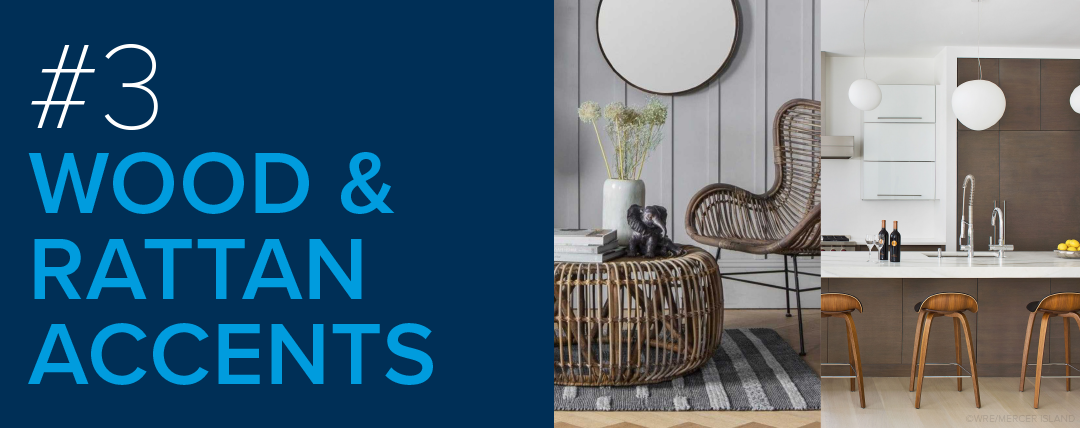
Dovetailing off the houseplant trend, natural materials are one of the years biggest trends—from wood-grain kitchen cabinets and countertops to rattan furniture and lighting fixtures. Natural wood-grain shelving and paneling are also increasing in prominence.
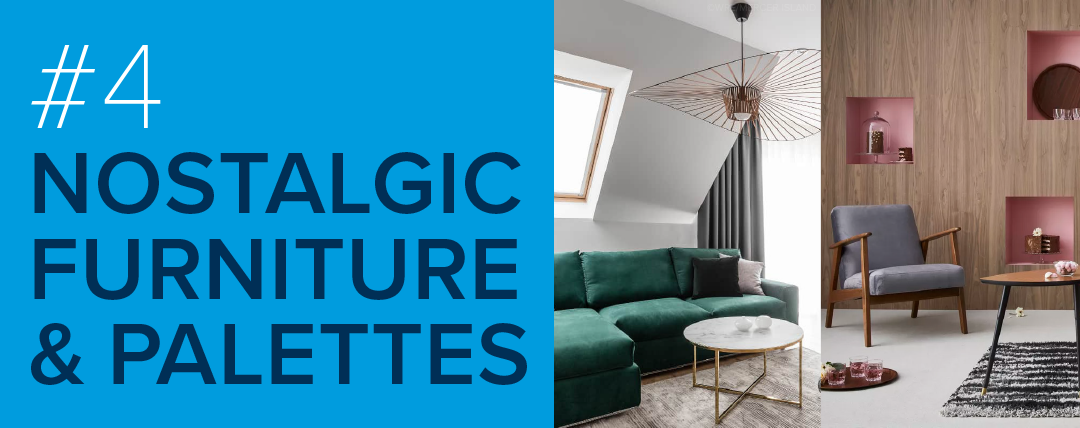
In the wake of 2020’s frightening new unknowns, people are seeking comfort with familiar throw-backs from simpler times. The funky mauve, emerald green and burnt orange of decades past are making a comeback along with paneled walls, ’80s curvy furniture and ’90s traditionalism. Retro art and accent pieces continue to be popular.
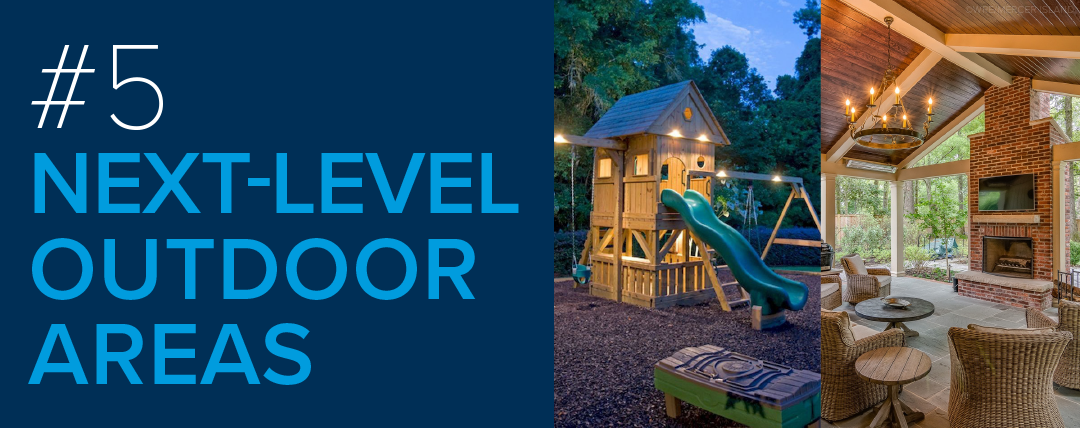
As winter contributes to our year-long cabin fever, more households are dreaming of bigger and better outdoor spaces. Park-like playgrounds, zip lines and DIY climbing walls are making an appearance in backyards. Safer al fresco entertaining spaces are also in demand with outdoor kitchens, dining areas and fire pits all on the rise.
Need an easy refresh? Try adding throw pillows, blankets or artwork in hues from Pantone’s Spring/Summer 2021 color palette.

Find a Home | Sell Your Home | Property Research
Neighborhoods | Market Reports | Our Team
We earn the trust and loyalty of our brokers and clients by doing real estate exceptionally well. The leader in our market, we deliver client-focused service in an authentic, collaborative and transparent manner and with the unmatched knowledge and expertise that comes from decades of experience.
2737 77th Ave SE, Mercer Island, WA 98040 | (206) 232-0446
© Copyright 2021, Windermere Real Estate / Mercer Island
2020 Home Trends


With 2020 now in full swing, we’re seeing some clear shifts in how homes are being designed and decorated. Most notable for our area is the Modern Farmhouse trend with its juxtapositions of old & new, light & dark, and clean & rustic. Softer grey and lagom neutrals are here to stay, but are now being contrasted with deep hues and warm metals. Organic materials such as natural wood and potted plants are also gaining prominence. Here are some key trends to consider as you refresh or renovate…

Deep blue is the “it” color in home decor, with Pantone’s “Classic Blue” and Sherwin-Williams’ “Naval” each taking color of the year honors. Navy accent walls are gaining popularity in smaller spaces such as foyers, dining rooms and powder rooms. Black is also back as an accent set against white in kitchens, living rooms and bathrooms. High-contrast graphics are making an appearance on wallpaper and bathroom tile.

Whether it’s antique artwork, floral wallpaper or vintage tile, old world charm is making a comeback…with a twist. This time around we’re seeing vintage framed art, patterns, woods and statement pieces being incorporated into modern spaces with clean lines. The Modern Farmhouse epitomizes this trend with its fresh new take on the old.
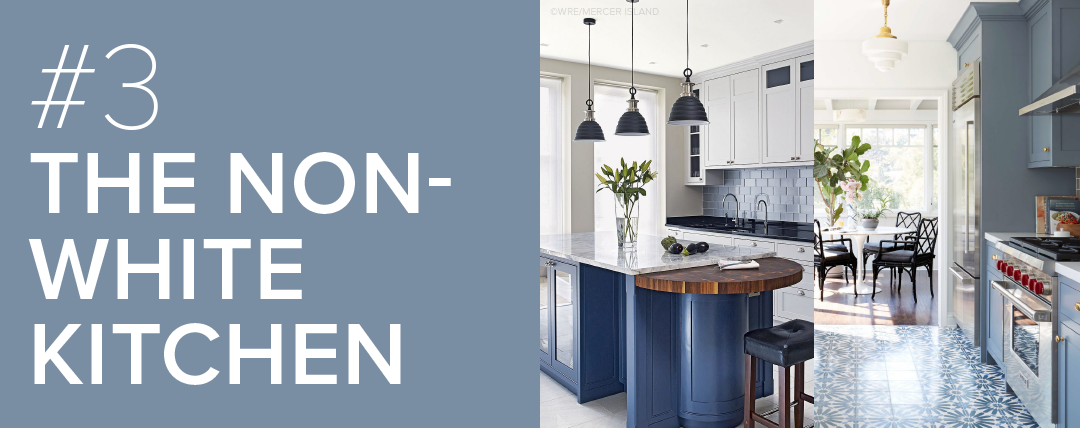
The all-white kitchen is making room for grey and painted cabinets to take the stage. For the daring, “color pop” cabinets in deep blue, black or even red have been cropping up in the modern kitchen. Kitchens that do have white cabinets are being spiced up with decorative tile floors and backsplashes, along with darker wood shelving and contrasting light fixtures.

Soft shearling, rustic leathers and fluffy textured mohairs are gradually replacing the luxe velvet we saw in years past. High performance outdoor-style fabrics have also gotten an upgrade and are appearing indoors on upholstered dining room chairs and couches. Cushy wing-backed dining benches and chairs are another notable trend, part of an emphasis on making dining rooms less formal and more comfortable. Another fun trend? Curved sofas for the dining room and kitchen.
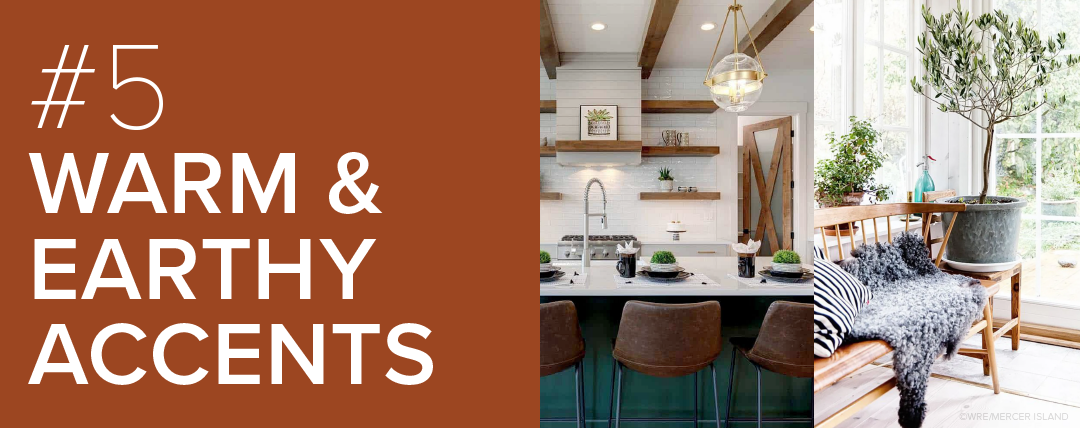
Matte brass continues its popularity in fixtures and frames, often mixed with silver metals. We’re seeing an infusion of aged wood accents, patina, rustic leathers and earthenware softening the clean lines of today’s minimalism. Potted plants are also popping up on shelves and in windows with olive trees usurping fig trees as a favorite statement piece.
Need an instant home update? Try adding throw pillows, blankets or artwork in hues from Pantone’s Spring/Summer 2020 color palette.

Find a Home | Sell Your Home | Property Research
Neighborhoods | Market Reports | Our Team
We earn the trust and loyalty of our brokers and clients by doing real estate exceptionally well. The leader in our market, we deliver client-focused service in an authentic, collaborative and transparent manner and with the unmatched knowledge and expertise that comes from decades of experience.
2737 77th Ave SE, Mercer Island, WA 98040 | (206) 232-0446
© Copyright 2020, Windermere Real Estate / Mercer Island
Planning for the Life Expectancy of Your Home


Nothing in life lasts forever – and the same can be said for your home. From the roof to the furnace, every component of your home has a lifespan, so it’s a good idea to know approximately how many years of service you can expect from them. This information can help when buying or selling your home, budgeting for improvements, and deciding between repairing or replacing when problems arise.
According to a National Association of Home Builders (NAHB) study, the average life expectancy of some home components has decreased over the past few decades. (This might explain why you’re on your third washing machine while Grandma still has the same indestructible model you remember from childhood.) But the good news is the lifespan of many other items has actually increased in recent years.
Here’s a look at the average life spans of some common home components (courtesy of NAHB).
APPLIANCES. Of all home components, appliances have the widest variation in life spans. These are averages for all brands and models and may represent the point which replacing is more cost-effective than repairing. Among major appliances, gas ranges have the longest life expectancy, at about 15 years. Electric ranges, standard-size refrigerators, and clothes dryers last about 13 years, while garbage disposals grind away for about 10 years. Dishwashers, microwave ovens, and mini-refrigerators can all be expected to last about nine years. For furnaces, expect a lifespan of about 15 years for electric, 18 for gas, and 20 for oil-burning models. Central air-conditioning systems generally beat the heat for 10 to 15 years.
KITCHEN & BATH. Countertops of wood, tile, and natural stone will last a lifetime, while cultured marble will last about 20 years. The lifespan of laminate countertops depends greatly on the use and can be 20 years or longer. Kitchen faucets generally last about 15 years. An enamel-coated steel sink will last five to 10 years; stainless will last at least 30 years; and slate, granite, soapstone, and copper should endure 100 years or longer. Toilets, on average, can serve at least 50 years (parts such as the wax ring, flush assembly, and seat will likely need replacing), and bathroom faucets tend to last about 20 years.
FLOORING. Natural flooring materials provide longevity as well as beauty: Wood, marble, slate, and granite should all last 100 years or longer, and tile, 74 to 100 years. Laminate products will survive 15 to 25 years, linoleum about 25 years, and vinyl should endure for about 50 years. Carpet will last eight to 10 years on average, depending on use and maintenance.
SIDING, ROOFING, WINDOWS & DECKS. Brick siding normally lasts 100 years or longer, aluminum siding about 80 years, and stucco about 25 years. The lifespan of wood siding varies dramatically – anywhere from 10 to 100 years – depending on the climate and level of maintenance. For roofs, slate or tile will last about 50 years, wood shingles can endure 25 to 30 years, the metal will last about 25 years, and asphalts got you covered for about 20 years. Unclad wood windows will last 30 years or longer, aluminum will last 15 to 20 years, and vinyl windows should keep their seals for 15 to 20 years. Cedar decks average 15-25 years if properly cleaned and treated, while high quality composite decks should easily last 30 years with minimal maintenance.
Of course, none of these averages matter if you have a roof that was improperly installed or a dishwasher that was a lemon right off the assembly line. In these cases, early replacement may be the best choice. Conversely, many household components will last longer than you need them to, as we often replace fully functional items for cosmetic reasons, out of a desire for more modern features, or as a part of a quest to be more energy efficient.
Are extended warranties warranted?
Extended warranties, also known as service contracts or service agreements, are sold for all types of household items, from appliances to electronics. They cover service calls and repairs for a specified time beyond the manufacturer’s standard warranty. Essentially, warranty providers (manufacturers, retailers, and outside companies) are betting that a product will be problem-free in the first years of operation, while the consumer who purchases a warranty is betting against reliability.
Warranty providers make a lot of money on extended warranties, and Consumers Union, which publishes Consumer Reports, advises against purchasing them. You will have to consider whether the cost is worth it to you; for some, it brings a much-needed peace of mind when making such a large purchase. Also, consider if it the cost outweighs the value of the item; in some cases, it may be less expensive to just replace a broken appliance than pay for insurance or a warranty.
ABOUT WINDERMERE MERCER ISLAND
We earn the trust and loyalty of our brokers and clients by doing real estate exceptionally well. The leader in our market, we deliver client-focused service in an authentic, collaborative and transparent manner and with the unmatched knowledge and expertise that comes from decades of experience.

© Copyright 2019, Windermere Real Estate/Mercer Island. Adapted from an article originally posted on Windermere.com.
Protect Your Investment: 5 Fall Maintenance To-Do’s

Benjamin Franklin once wrote, “An ounce of prevention is worth a pound of cure.” While he was talking about fire safety, I think it applies equally well to home maintenance. One weekend of prevention this fall can save you many headaches (and a lot of money) down the road. Here are a few ideas to get you started:
Gutters top to bottom: Water in the wrong spots can do a lot of damage. Start by ensuring that gutters and downspouts are doing their job. (You may want to hire a professional, especially if you have a two-story house with a steep roof.) If your home is surrounded by deciduous trees you may need to clean out your gutters a few times a year, especially in the fall. Check to make sure your gutters are flush with the roof and attached securely, repairing any areas that sag or where the water collects and overflows. Clean out the gutters and downspouts, checking that outlet strainers are in good shape, and are firmly in place. Finally, check that your downspouts direct water away from your house, not straight along the foundation.
Check for leaks: The best opportunity to catch leaks is the first heavy rain after a long dry spell. Check the underside of the roof, looking for moisture on joints or insulation. Mark any spots that you find and then hire a roofing specialist to repair these leaks. If you wait until spots show up on your ceiling, insulation and sheet rock will have also been damaged and you could have a mold problem too. You can find tips on how to solve roof & gutter issues in this great article from http://FamilyHandyman.com.
Don’t forget the basement and the caulking around windows & doors. Check your foundation for cracks, erosion and gaps in window and door weathering. Make sure to properly seal any leaks while the weather is nice. This will ensure materials dry properly.
Pest Prevention: Rodents are determined and opportunistic, and they can do tremendous amounts of property damage (and endanger your family’s health). As temperatures cool, take measures to prevent roof rats and other critters from moving in. Branches that touch your house and overhang your roof are convenient on-ramps for invaders, so trim back branches so they’re at least four feet from the house. If you do hear scuttling overhead or discover rodent droppings in your attic, crawl space or basement, take immediate action. The website http://www.thisoldhouse.com has several helpful articles on the topic.
Maintain your heating and cooling systems: Preventative maintenance is especially crucial for your home’s heating and air-conditioning systems. Fall is a smart time to have your systems checked and tuned up if necessary. Don’t wait for extreme temperatures to arrive, when service companies are slammed with emergency calls. Between tune-ups, keeps your system performing optimally by cleaning and/or replacing air filters as needed.
If you have a wood-burning fireplace, a professional inspection and cleaning will help prevent potentially lethal chimney fires and carbon monoxide poisoning. Even if you don’t use your fireplace often, it’s a good idea to keep a supply of dry firewood or sawdust-composite logs so you have a backup heat source in an emergency. Gas fireplaces should be serviced about every 2 years to lengthen their lifespans.
Insulate & seal: Insulating your home is a cost-efficient investment, whether you’re trying to keep the interior warm in the winter or cool in the summer. Aside from more major improvements like energy-efficient windows and insulation, there are some quick fixes that do-it-yourselfers can tackle. If an exterior door doesn’t have a snug seal when closed, replace the weather stripping; self-adhesive foam stripping is much simpler to install than traditional vinyl stripping. If there is a gap under the door (which can happen over time as a house settles), you may need to realign the door and replace the vinyl door bottom and/or door sweep. Air also sneaks inside through electrical outlets and light switches on exterior walls. Dye-cut foam outlet seals placed behind the wall plates are a quick and inexpensive solution.
 Facebook
Facebook
 Twitter
Twitter
 Pinterest
Pinterest
 Copy Link
Copy Link






